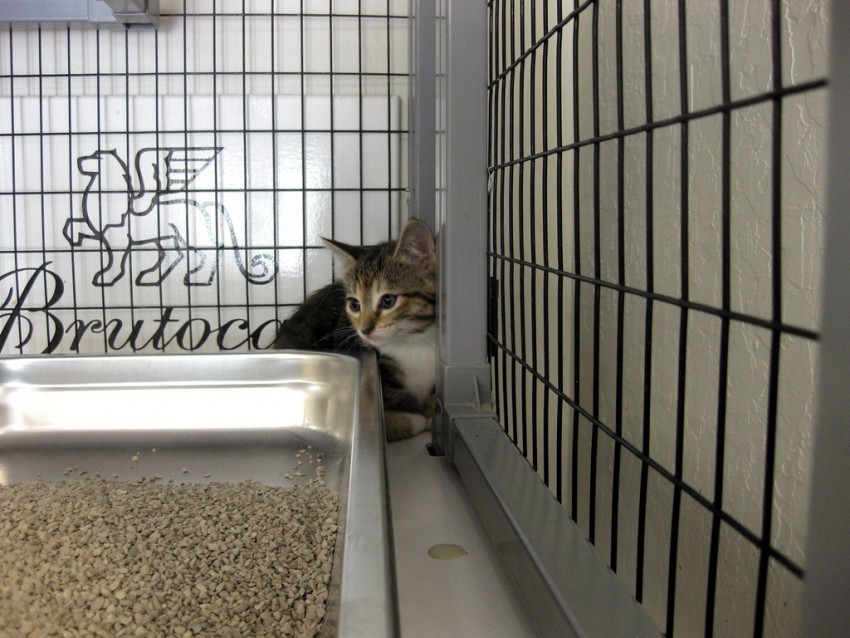
Table of Contents
People volunteer with animals for many reasons, but not everyone is ready for the commitment involved.
If you’re wondering “what do volunteers do at animal shelters”, the answer is much more complex than just petting kittens and walking puppies; shelters need a lot more from their volunteers. Here’s some important information on how to volunteer at an animal shelter.
First, contact your preferred shelter and find out what their volunteer needs are. Although many shelters are always in need of extra hands, some are fortunate enough to have more than enough volunteers and may have a waiting list.
You may be required to:
- Fill out an application
- Attend an orientation
- Make a tax-deductible donation (to cover potential costs associated with volunteering)
- Participate in training courses
- Sign a liability waiver
Every shelter follows its own set of guidelines regarding volunteers. Some have rigid procedures; others require no more than a signature and identification before handing over a leash.

Responsibilities When Volunteering at an Animal Shelter
You may wonder what sort of duties you could be responsible for as a volunteer and be wondering what do you do when you volunteer at an animal shelter. Chances are your shelter is wondering what sort of duties you’d be willing to perform beyond playing the day away with masses of puppies.
Although lots of face time with puppies and kittens may very well be requested of you, other needs may include:
- Walking dogs
- Socializing cats
- Showing pets to potential adopters
- Cleaning, cleaning, cleaning
- Photographing pets
- Landscaping
- Office tasks such as printing or copying
- Fostering
Decide what tasks you’d be most comfortable with initially and make sure the staff is aware of any limitations you have. As you spend more time volunteering, you’ll find a good routine and may even take on more hours and responsibilities.
Check out this video of some of the jobs performed by animal shelter volunteers at mrspac:
Commitment When Volunteering at an Animal Shelter
Because most are nonprofits, shelters need volunteers to keep operations running smoothly and the doors open to the public.
If volunteers are in such dire need, then, why do some shelters have such complicated application processes? Believe it or not, it’s not to frustrate or deter you — it’s to ensure that you are committed and reliable.
Too often, shelters receive interest from people who aren’t prepared to dedicate more than 1 or 2 visits at the most. If each volunteer needs training to handle the animals and understand standard procedures, the process is a waste when trained volunteers quit after spending as little as 20 minutes playing with the animals.
Here’s what you can do to prepare yourself for volunteering:
- Set aside at least 2 hours per week specifically for spending at the shelter.
- Turn your volunteer time into part of your routine so it’s harder to skip.
- Consider becoming a volunteer with a friend or family member so you can go together.
Reliability is one of the most important characteristics needed in volunteers. Shelters need to know they can count on a core group of people to help the animals stay healthy and happy. So if you know that you plan to volunteer only for a limited time, inform the staff when you apply.
Here are some of the other character traits that can be useful when volunteering at an animal shelter:
- Responsible
- Open to learning new things
- Loves animals
- And more!

15 Things to Know Before Volunteering at an Animal Shelter
Volunteering at an animal shelter can be a rewarding experience with many benefits. It also helps shelters that are low on labor continue their endless care of animals.
Shelters are not all created equal, and volunteering can be very different from one city to the next.
If you’re thinking of helping out at your local shelter and are curious about how to volunteer at an animal shelter, here are some things you need to know before grabbing your volunteer T-shirt and diving straight in:
Was YOUR Pet Food Recalled?
Check Now: Blue Buffalo • Science Diet • Purina • Wellness • 4health • Canine Carry Outs • Friskies • Taste of the Wild • See 200+ more brands…

1. Time Commitment
Shelters may have a set schedule for their volunteers, so you might not be able to sign up for just an event or pop in when you have a free day.
There might also be a minimum amount of hours to meet to keep your volunteer title, so always ask up front what’s expected of you.
2. Training Requirements
You may be required to complete a training program or class before you can work at the shelter. Training may be given for each individual or, like at my shelter, held only once per month.
Ask when the next training will be available and how long it will take.
3. Tasks Involved
This item is particularly important. What you may end up doing can be far from what you imagine.
- Are you allergic to cats but not dogs, or vice versa?
- Do you detest poop but are happy to pass out fliers or answer the phones?
If you’re wondering what do animal shelter volunteers do, there are many tasks involved for the shelter to keep running, so ask what is available and see which tasks you prefer to tackle.
4. Animal Types and Sizes
Check to see what types of animals are housed or taken in at the shelter before signing up.
Most shelters have cats and dogs, but some may take in birds, rats or snakes. If you have an aversion to any type of animal, ask which ones you will be expected to assist.
Some shelters have separate buildings for cats and dogs.
5. Weather Conditions
Indoor areas are normally climate-controlled, but you may have to work in outdoor areas or runs for the animals.
Extreme heat or cold may be possible depending on your location, so be prepared to work with the elements or request indoor-only work.

6. Accident and Injury Policy
You may be volunteering at your own risk. Some facilities may require you to sign a waiver so that they will not be held liable if you are injured or involved in an accident.
If this is a major concern for you, ask about it in advance.
7. Equipment Use
Different types of equipment may be required for certain jobs.
Ask about the tools you will need to perform for your volunteering duties in case it’s something unexpected. Office work uses pretty standard equipment, but you might need to use pressure washers or construction equipment.
8. Noise Level
Even though shelters may take excellent care of their animals, even my own facility can be ear splitting with nonstop barking at times.
The cat cottage is much quieter, but if noise is a concern you might want to ask where you will be working and with which animals. Ear plugs are not an unusual sight.
9. Scared Animals
Not every animal at the shelter is used to being there or enjoys their surroundings, and they may be just as scared of you as you are of them.
As you get to know the animals, they can become more comfortable around you.
If you are unsure about approaching an animal, ask a shelter employee for assistance first. Accidents can and do happen, and sometimes a scratch or bite is just a scared animal’s way of trying to protect itself.
10. Applications
Shelters may require you to complete a paper or online application before you can be considered for volunteer work.
These applications can vary greatly. Some may ask for basic information such as your address or phone number, while others may require employment history, references and more.
Ask for a sample application if it’s required, and feel free to ask questions about the information they are requesting.
11. Allergies
Even if your duties restrict you to an office, being inside an animal shelter is a sure bet that you will come into contact with pet hair and dander. This shouldn’t deter you, though — there are plenty of ways you can help the shelter without having to be inside.
Graphic design, passing out handbills, volunteering at a fundraiser and more are all great ways to get involved without the fur flying by your nose.
12. Volunteer Overload
Shelters can be overflowing with volunteers sometimes, and they may not need or want to take on additional volunteers. Don’t fret.
Check around at other shelters or call rescue organizations to see if they can use some help. This could be anything from working with the animals to doing graphic design or helping them advertise available animals for adoption.
13. Shelter Expectations
If you haven’t been to your local shelter yet, stop by and ask for a tour. Shelters are operated differently — some may resemble a clinic or zoo while others are underfunded and understaffed. If your priority is helping a no-kill shelter, ask if they euthanize animals before you sign up.
Many shelters operate veterinary services at their locations, and those will involve euthanizations for ill pets. The type of euthanasia mentioned previously refers to shelters that euthanize animals due to overcrowding.
Unfortunately, many places still do this across the country, so ask up front if it’s a sticky point for you.
14. Animal Person May Not Equal a People Person
Some people work with animals because they prefer their company over people. In short, don’t take offense if someone seems a little quiet or shy. You have a common interest at heart, and talking about animals is a sure way to strike up a conversation.
15. Heartbreak
If you volunteer at a kill shelter, it can be heartbreaking to see animals you have come to know and love be taken for euthanasia. Even in a no-kill shelter like mine it’s easy to get attached to the animals and miss them once they are adopted.
You will also see animals in pain, dealing with injuries, trying to recover from abuse or even being returned after being adopted.
The key to being fully prepared before volunteering is getting the answers to the above questions. Also, be honest and realistic about how much time and effort you can spare.

7 Benefits of Volunteering at an Animal Shelter
From a practical standpoint, volunteering for a nonprofit organization is a great addition to your resume. It is also an easy way to open some doors if you’re looking to land a paying job in a shelter.
Here are 7 benefits of volunteering at an animal shelter:
1. Meet new friends. You will be surrounded by people who love animals as much as you do, and they might even become your lifelong friends. This widens your social circle and incorporates compassionate people who share your interest in helping animals. Guinea pigs, rabbits and even birds end up in shelters, so you’ll also learn about other animals too.
2. Your efforts will help an animal get ready and increase its chances for a new home. Animals coming into the shelter vary according to their needs. A feral cat may need to be socialized, a dog may have mats to remove or a guinea pig may be underweight. Animals that appear happy and healthy have a higher chance of being adopted, and shelters need your help to achieve this.
3. Boost your mood — and your health. Volunteering gives us a sense of satisfaction for helping others, can lower stress, make you feel needed and appreciated, increase happiness and so much more. A study reported on in Natural Health magazine in 2007 showed that 95% of volunteers surveyed said they gained a “helper’s high” — a feeling of euphoria and energy. Volunteering truly is a feel-good activity, and what better way to spend the day than with cuddly and furry friends?
4. Gain experience. Whether you’re working the phones, stuffing mailers, grooming or arranging meet-and-greet sessions with potential owners, you are gaining experience in many areas that can have great benefits in other areas of your life. Young adults can become better acquainted with animals, experience a set schedule of responsibilities, and gain a reference for an employment or college application. Working adults may include it on their resume or incorporate animal shelters into their work-related events and charitable causes. Someone who is unemployed can get a boost of self-esteem and confidence by being part of a vital team while looking for work.
5. Trying something new is fun! A new activity can be exciting and a change of pace for a mundane or repetitive schedule. Why not make that something new be volunteering? You will gain a host of other benefits, and the rush of happiness when a pet you helped gets a new “forever home” is nothing short of amazing.
6. Stay active. Being a volunteer keeps your mind, body and emotions active and healthy. Sitting at home on weekends in front of a television can get boring and leave many of your talents unused. Volunteering that time instead keeps you thinking, moving and feeling, and can help increase physical mobility. Besides, playing with a puppy sounds much more fun than being a couch potato!
7. Become part of a very important team. Animal shelters need money and people to stay open. Some of them face closure constantly, and you could be that one extra hand that helps another pet get adopted, shepherds through another donation or encourages a new person to volunteer. The ASPCA estimates that there are about 5,000 shelters across the country, and these shelters take in an average of five to seven million animals per year. The animals keep coming, and more people are needed every day.
Volunteering can be a long-term commitment and may not always be easy or convenient, but if you can stick with it, volunteering with animals is one of the most rewarding experiences available. All it requires is a little dedication and a whole lot of love.
Frequently Asked Questions (FAQ)
How Does Volunteering at an Animal Shelter Help the Community?
Volunteering at animal shelters helps them stay open because you are providing important services. It also helps members of the community by ensuring there is a place that houses animals and keeps them happy and healthy so that they can find a pet to take home and love. Volunteering at an animal shelter also gives you a chance to work with others who share the same love of animals which helps foster a sense of community and creates a bond with new people.
Is Volunteering at an Animal Shelter Community Service?
Being an animal shelter volunteer is often an unpaid position where you volunteer your time and energy for the betterment of the shelter and its services, and therefore the community.
How Old Do You Have to be to Volunteer at an Animal Shelter?
If you’re asking “how do you volunteer at an animal shelter” and what the age requirements are, then its important to know that the criteria varies. Different cities and countries will have different age requirements for working with animals and volunteering at their shelters. In general, 15-16 years old is a common age for people to begin volunteering at an animal shelter, but it can vary from state to state so it is best to check in with your local shelter and ask around for information regarding age requirements.
* * *
Kristine Lacoste, Petful’s editor in chief — and an animal shelter volunteer — contributed to this article.


